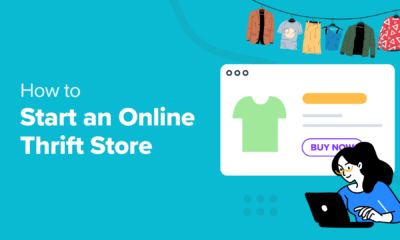SOCIAL
Russia’s Invasion of Ukraine Represents a New, Key Stage in the Battle Against Online Misinformation

Russia’s invasion of Ukraine has marked a new inflection point for social media, and the role that it plays in the modern information ecosystem. Now, after years of dismissals about the influence of social platforms, and how social media trends can drive real world action, we’re seeing faster, more responsive approaches to potentially harmful messaging, which has played a key role in limiting the spread of misinformation, and quashing counter-narratives that have the potential to both erode support and undermine action.
Yet, at the same time, those very same shifts highlight the importance of social platforms as propaganda tools, and how they can be – and have been – used as a means to increasingly control narratives around political and cultural events.
Which begs the question – is it better to have social platforms cut off entirely for certain regions, or does that merely grant more space for government-controlled media to fill those gaps, and dictate messaging as it sees fit?
Of course, none of the platforms themselves have chosen to be cut off – both Facebook and Twitter are reportedly either limited or cut off entirely within Russia at present, due to their refusal to comply with the Kremlin’s demands to stop censoring state-affiliated media. But even so, the lack of outside information sources likely has a massive impact on how Russian citizens perceive the action in Ukraine, with various reports showing that many Russians are indeed in support of Putin’s decisions, despite almost unanimous worldwide condemnation.
But without external input, it’s quite possible that Russians are simply unaware of the global response – or at the least, they likely have a lessened perception of such. Which is a risk of Russia being cut off – now, the only information that Russians have is largely via Kremlin-controlled channels, which can’t be good for broader understanding.
At the same time, there’s not much the platforms themselves can do about this. The only option they have is to comply, and enable their platforms to be used to spread misinformation. Which also leads to the counter concern – without being able to hear the other side, how do we know that we’re getting the full story? The quashing of pro-Russian narratives means that the platforms do indeed have control over information flow, and while the suppression of such extends well beyond social media alone in this instance, it does reinforce the fact that the news and information we see can be controlled, or at least influenced, by private organizations.
In most cases, this is in line with broader government sanctions, but still, that’s at least something of a concern.
So where are we at right now?
Currently, as per latest reports:
- Both Facebook and Twitter have been restricted or cut off in Russia, limiting the capacity for Russian users to share their perspectives beyond the nation’s borders
- Russian state media has been banned from YouTube and TikTok for users in Europe, while both are now looking to ban uploads in Russia due to the Kremlin’s new ‘fake news’ law. Reddit has also banned links to Russian state media sites
- Ads from Russian-based organizations have been banned on Facebook, Twitter, YouTube, Google and Snapchat
So pro-Russian messaging is severely limited on western social media apps, and each platform continues to work hard to stop the spread of misinformation by tackling it before it can take hold.
The positive of this, as noted, is that we’re finally seeing this element taken more seriously, and we’re finally seeing platforms take more definitive, proactive stances on potentially harmful misinformation before it’s too late. Platforms dismissed trends like the rise of QAnon for far too long, despite repeated warnings, preferring to let users exercise their rights to free speech, and explaining it away as just that, just talk among niche groups. Now we know where that can lead, and it’s a major positive to see immediate reaction on misinformation in this case, which has played a big role in limiting its impact.
That, really, is what’s needed, and it feels like the key learning of the past decade of evolving social media usage.
But then again, that’s also reliant on there being a definitive truth, and for the platforms themselves to decide on such quickly. In this case, that’s clear, based on global response, but it won’t always be so straightforward.
So while social platforms are being praised for their rapid response in this instance, and it does feel like a significant point in the battle against online misinformation campaigns, it may not be indicative, as such, and it may not limit the next rising, dangerous trend.
Unless a definitive battle plan is established. What we need now is for the platforms to work together, as an industry, in partnership with third-party fact-checkers and other legal and/or academic groups, to firm up a process of making rapid decisions on potentially dangerous trends, as soon as they’re detected, in order to ensure ongoing proactive response to limit such.
It feels like we’re at the next stage in the battle, given the current action we’re seeing, but that may not be the case, and it’s important that we recognize the value of the response that we’re seeing right now, in order to define future action on the same.
But that does, inevitably, implement a level of control over ‘free speech’ online – and if we’re essentially only seeing messages that have been approved by a network of fact checkers, corporations and even government-aligned groups (in the case of regulation) is that much better than Russia or China pushing their messages via state-affiliated partners?
It seems like it is, and you would assume that the power of democracy holds more strength in this regard, with respect to allowing a level of healthy scrutiny. But it’s a question that will inevitably come up as we look to integrate lessons learned to improve online information flow.
SOCIAL
Snapchat Explores New Messaging Retention Feature: A Game-Changer or Risky Move?

In a recent announcement, Snapchat revealed a groundbreaking update that challenges its traditional design ethos. The platform is experimenting with an option that allows users to defy the 24-hour auto-delete rule, a feature synonymous with Snapchat’s ephemeral messaging model.
The proposed change aims to introduce a “Never delete” option in messaging retention settings, aligning Snapchat more closely with conventional messaging apps. While this move may blur Snapchat’s distinctive selling point, Snap appears convinced of its necessity.
According to Snap, the decision stems from user feedback and a commitment to innovation based on user needs. The company aims to provide greater flexibility and control over conversations, catering to the preferences of its community.
Currently undergoing trials in select markets, the new feature empowers users to adjust retention settings on a conversation-by-conversation basis. Flexibility remains paramount, with participants able to modify settings within chats and receive in-chat notifications to ensure transparency.
Snapchat underscores that the default auto-delete feature will persist, reinforcing its design philosophy centered on ephemerality. However, with the app gaining traction as a primary messaging platform, the option offers users a means to preserve longer chat histories.
The update marks a pivotal moment for Snapchat, renowned for its disappearing message premise, especially popular among younger demographics. Retaining this focus has been pivotal to Snapchat’s identity, but the shift suggests a broader strategy aimed at diversifying its user base.
This strategy may appeal particularly to older demographics, potentially extending Snapchat’s relevance as users age. By emulating features of conventional messaging platforms, Snapchat seeks to enhance its appeal and broaden its reach.
Yet, the introduction of message retention poses questions about Snapchat’s uniqueness. While addressing user demands, the risk of diluting Snapchat’s distinctiveness looms large.
As Snapchat ventures into uncharted territory, the outcome of this experiment remains uncertain. Will message retention propel Snapchat to new heights, or will it compromise the platform’s uniqueness?
Only time will tell.
SOCIAL
Catering to specific audience boosts your business, says accountant turned coach

While it is tempting to try to appeal to a broad audience, the founder of alcohol-free coaching service Just the Tonic, Sandra Parker, believes the best thing you can do for your business is focus on your niche. Here’s how she did just that.
When running a business, reaching out to as many clients as possible can be tempting. But it also risks making your marketing “too generic,” warns Sandra Parker, the founder of Just The Tonic Coaching.
“From the very start of my business, I knew exactly who I could help and who I couldn’t,” Parker told My Biggest Lessons.
Parker struggled with alcohol dependence as a young professional. Today, her business targets high-achieving individuals who face challenges similar to those she had early in her career.
“I understand their frustrations, I understand their fears, and I understand their coping mechanisms and the stories they’re telling themselves,” Parker said. “Because of that, I’m able to market very effectively, to speak in a language that they understand, and am able to reach them.”Â
“I believe that it’s really important that you know exactly who your customer or your client is, and you target them, and you resist the temptation to make your marketing too generic to try and reach everyone,” she explained.
“If you speak specifically to your target clients, you will reach them, and I believe that’s the way that you’re going to be more successful.
Watch the video for more of Sandra Parker’s biggest lessons.
SOCIAL
Instagram Tests Live-Stream Games to Enhance Engagement

Instagram’s testing out some new options to help spice up your live-streams in the app, with some live broadcasters now able to select a game that they can play with viewers in-stream.
As you can see in these example screens, posted by Ahmed Ghanem, some creators now have the option to play either “This or That”, a question and answer prompt that you can share with your viewers, or “Trivia”, to generate more engagement within your IG live-streams.
That could be a simple way to spark more conversation and interaction, which could then lead into further engagement opportunities from your live audience.
Meta’s been exploring more ways to make live-streaming a bigger consideration for IG creators, with a view to live-streams potentially catching on with more users.
That includes the gradual expansion of its “Stars” live-stream donation program, giving more creators in more regions a means to accept donations from live-stream viewers, while back in December, Instagram also added some new options to make it easier to go live using third-party tools via desktop PCs.
Live streaming has been a major shift in China, where shopping live-streams, in particular, have led to massive opportunities for streaming platforms. They haven’t caught on in the same way in Western regions, but as TikTok and YouTube look to push live-stream adoption, there is still a chance that they will become a much bigger element in future.
Which is why IG is also trying to stay in touch, and add more ways for its creators to engage via streams. Live-stream games is another element within this, which could make this a better community-building, and potentially sales-driving option.
We’ve asked Instagram for more information on this test, and we’ll update this post if/when we hear back.
-

 PPC4 days ago
PPC4 days ago19 Best SEO Tools in 2024 (For Every Use Case)
-

 MARKETING7 days ago
MARKETING7 days agoWill Google Buy HubSpot? | Content Marketing Institute
-
SEARCHENGINES7 days ago
Daily Search Forum Recap: April 16, 2024
-

 SEO7 days ago
SEO7 days agoGoogle Clarifies Vacation Rental Structured Data
-

 MARKETING6 days ago
MARKETING6 days agoStreamlining Processes for Increased Efficiency and Results
-
SEARCHENGINES6 days ago
Daily Search Forum Recap: April 17, 2024
-

 PPC7 days ago
PPC7 days agoHow to Collect & Use Customer Data the Right (& Ethical) Way
-

 SEO6 days ago
SEO6 days agoAn In-Depth Guide And Best Practices For Mobile SEO
















You must be logged in to post a comment Login